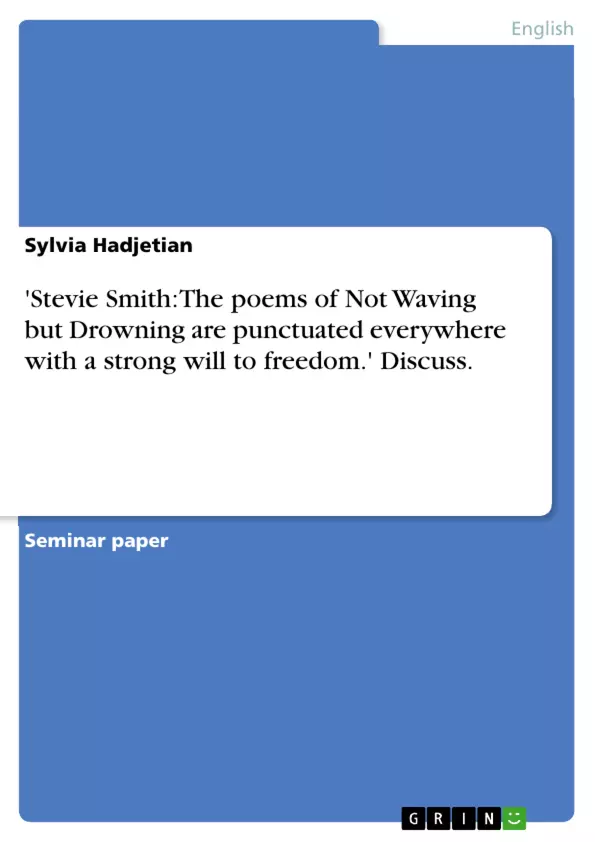Introduction
Stevie Smith’s fifth volume of verse Not Waving but Drowning was published in 1957. Pain, sadness, despair and death are common subjects in these poems and they are all punctuated everywhere by a strong will to freedom. Freedom is the right to live or act without being restricted by anyone or anything; freedom is the state of not being a prisoner or a slave. In her poems, Stevie Smith deals with different kinds of freedom. The will to freedom is not always fulfilled easily or at all. This essay will discuss the reasons for the will of freedom that are presented in certain poems of Not Waving but Drowning, it will deal with the possible fulfilment of freedom and the conditions for it.
Table of Contents
- 1. Introduction
- 2. The will to freedom
- 2.1 My Hat
- 2.2 The Queen and the Young Princess
- 2.3 The English Visitor
Objectives and Key Themes
This essay examines the theme of freedom in Stevie Smith's poetry, specifically within the collection *Not Waving but Drowning*. It explores the various manifestations of the "will to freedom" depicted in the poems, the conditions required for its attainment, and the potential consequences of its pursuit.
- The desire for freedom from societal expectations and familial pressure.
- The contrasting portrayals of freedom as escape and as death.
- The complexities and conditions associated with achieving freedom.
- The tension between individual desires and societal norms.
- The use of symbolism and imagery to represent freedom and its limitations.
Chapter Summaries
1. Introduction: This introductory chapter sets the stage for the essay by introducing Stevie Smith's *Not Waving but Drowning* and its central theme: the pervasive "strong will to freedom" amidst pain, sadness, despair, and death. It establishes the essay's objective to analyze the reasons behind this will to freedom, the possibility of its fulfillment, and the conditions surrounding it. The chapter defines freedom as the absence of restriction and constraint, highlighting that Smith explores various forms of freedom in her poetry, and not all are easily achieved.
2. The will to freedom: This chapter delves into three poems—"My Hat," "The Queen and the Young Princess," and "The English Visitor"—to explore the theme of the will to freedom. In "My Hat," a young girl seeks freedom from her family's expectations of marriage, finding liberation in a metaphorical escape represented by a hat. This escape, however, comes at the cost of isolation on a desert island. "The Queen and the Young Princess" examines a princess's thwarted desire for freedom, suppressed by her mother's expectations. "The English Visitor" portrays a woman who escapes a hostile village community to achieve freedom, but only by abandoning the grave of her beloved. The chapter connects these poems to the post-World War I context, highlighting Smith's challenge to traditional gender roles and domestic ideology.
Keywords
Stevie Smith, Not Waving but Drowning, freedom, societal expectations, familial pressure, escape, death, rebellion, gender roles, domestic ideology, symbolism, poetry.
Stevie Smith's *Not Waving but Drowning*: A Thematic Analysis - FAQ
What is the main focus of this analysis?
This analysis examines the theme of freedom in Stevie Smith's poetry, specifically within her collection *Not Waving but Drowning*. It explores how the "will to freedom" manifests in her poems, the conditions for achieving it, and its potential consequences.
What are the key themes explored in the analysis?
The analysis explores several key themes, including the desire for freedom from societal expectations and familial pressure; contrasting portrayals of freedom as escape and as death; the complexities and conditions associated with achieving freedom; the tension between individual desires and societal norms; and the use of symbolism and imagery to represent freedom and its limitations.
Which poems are analyzed in detail?
The analysis focuses on three poems from *Not Waving but Drowning*: "My Hat," "The Queen and the Young Princess," and "The English Visitor." Each poem illustrates different aspects of the "will to freedom" and its implications.
How are the poems interpreted in relation to the theme of freedom?
In "My Hat," freedom is portrayed as escape from familial expectations, though this escape leads to isolation. "The Queen and the Young Princess" shows a thwarted desire for freedom due to societal constraints. "The English Visitor" depicts freedom achieved through escape, but at a significant emotional cost.
What is the historical context considered in the analysis?
The analysis connects the poems to the post-World War I context, highlighting Smith's challenge to traditional gender roles and domestic ideology prevalent during that time.
What are the chapter summaries provided in the document?
The document provides summaries for an introduction chapter, which sets the stage and defines the scope of the analysis, and a second chapter focusing on the three poems mentioned above, exploring the complexities of the "will to freedom" within them and tying them to the historical context.
What are the objectives of this analysis?
The objective is to analyze the reasons behind the "will to freedom" in Smith's poetry, the possibility of its fulfillment, and the conditions that surround it. It aims to understand the various manifestations of freedom and its potential costs.
What keywords are associated with this analysis?
Keywords include: Stevie Smith, *Not Waving but Drowning*, freedom, societal expectations, familial pressure, escape, death, rebellion, gender roles, domestic ideology, symbolism, poetry.
What is the overall structure of the document?
The document is structured with a table of contents, an overview of objectives and key themes, chapter summaries, and a list of keywords. This allows for a structured and comprehensive understanding of the analysis.
- Arbeit zitieren
- Sylvia Hadjetian (Autor:in), 2001, 'Stevie Smith: The poems of Not Waving but Drowning are punctuated everywhere with a strong will to freedom.' Discuss., München, GRIN Verlag, https://www.grin.com/document/43119



